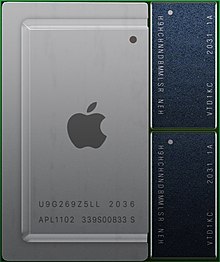
Back نظام على رقاقة Arabic Çip üzərində sistem Azerbaijani Едночипова система Bulgarian এক চিলতে-ভিত্তিক ব্যবস্থা Bengali/Bangla Sistem na čipu BS SoC Catalan Systém na čipu Czech System-on-a-Chip German System-on-chip Esperanto Sistema en un chip Spanish


A system on a chip or system-on-chip (SoC /ˌˈɛsoʊsiː/; pl. SoCs /ˌˈɛsoʊsiːz/) is an integrated circuit that integrates most or all components of a computer or electronic system. These components usually include an on-chip central processing unit (CPU), memory interfaces, input/output devices and interfaces, and secondary storage interfaces, often alongside other components such as radio modems and a graphics processing unit (GPU) – all on a single substrate or microchip.[1] SoCs may contain digital and also analog, mixed-signal and often radio frequency signal processing functions (otherwise it may be considered on a discrete application processor).
High-performance SoCs are often paired with dedicated and physically separate memory and secondary storage (such as LPDDR and eUFS or eMMC, respectively) chips that may be layered on top of the SoC in what is known as a package on package (PoP) configuration, or be placed close to the SoC. Additionally, SoCs may use separate wireless modems (especially WWAN modems).[2]
An SoC integrates a microcontroller, microprocessor or perhaps several processor cores with peripherals like a GPU, Wi-Fi and cellular network radio modems or one or more coprocessors. Similar to how a microcontroller integrates a microprocessor with peripheral circuits and memory, an SoC can be seen as integrating a microcontroller with even more advanced peripherals.
Compared to a multi-chip architecture, an SoC with equivalent functionality will have reduced power consumption as well as a smaller semiconductor die area. This comes at the cost of reduced replaceability of components. By definition, SoC designs are fully or nearly fully integrated across different component modules. For these reasons, there has been a general trend towards tighter integration of components in the computer hardware industry, in part due to the influence of SoCs and lessons learned from the mobile and embedded computing markets.
SoCs are very common in the mobile computing (as in smart devices such as smartphones and tablet computers) and edge computing markets.[3][4]
- ^ Shah, Agam (January 3, 2017). "7 dazzling smartphone improvements with Qualcomm's Snapdragon 835 chip". Network World.
- ^ Amadeo, R. (February 18, 2020). "Qualcomm's Snapdragon X60 promises smaller 5G modems in 2021". Ars Technica. Conde Nast. Retrieved December 17, 2023.
- ^ Pete Bennett, EE Times. "The why, where and what of low-power SoC design." December 2, 2004. Retrieved July 28, 2015.
- ^ Nolan, Stephen M. "Power Management for Internet of Things (IoT) System on a Chip (SoC) Development". Design And Reuse. Retrieved September 25, 2018.